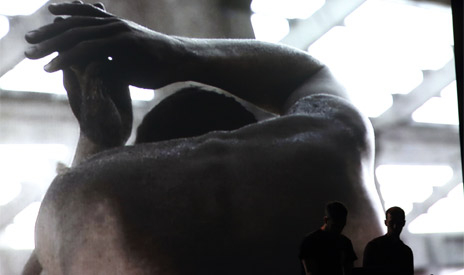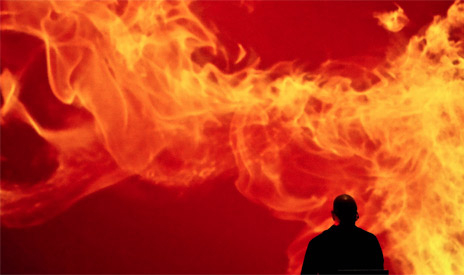- Despite being one of the preeminent cultural events in Australia, it wasn't until this year that the Adelaide Festival appeared on the radar for electronic music buffs. The announcement of three consecutive nights presented by the Unsound Festival, plus Atom TM and Severed Heads on a double bill one evening, was enough to draw fans from all over the country. Tim Hecker, Oneohtrix Point Never, Lustmord, Hype Williams and Raime were just a few names on a long list of acts making the journey to Adelaide. For most of them it would be a one-off Australian appearance.
Atom TM's opening set might have raised a few eyebrows among Adelaide Festival traditionalists. Uwe Schmidt stood alone onstage, flanked by screens showing an amusing range of home videos, including a pornographic loop of felatio. (All of this, and more, brought to you by the Adelaide taxpayers.) This was a tough act for Severed Heads to follow. Tom Ellard was entertaining and comical as always, but his awkward stage presence made it clear that he'd not performed in a long time. He and Atom TM sharing a bill did make sense—both artists perform satire, albeit in vastly different forms. Schmidt presented a more stately and disciplined theatre, while Ellard delivered a downright pisstake.
All three nights of Unsound were sold out. Raime, who replaced Emeralds at short notice, performed their debut album, Quarter Turns Over A Living Line. A cinematic backdrop cast the duo as faceless silhouettes as they did everything they could to enhance their LP's shuddering atmospheres. Their accompanying footage was slowed to a snail's pace, which lengthened the eternity between beats in tracks like "The Walker In Blast And Bottle" and "Exist In The Repeat of Practice."
 Photo credit: Tony Lewis
Video played a central role in most performances. Trinity, a project by Lustmord, Biosphere and video collective MFO, explored the first nuclear weapons tests in New Mexico. Beautifully rendered portraits and landscapes were so arresting that the music served only to bolster the images' impact (which was probably the point).
Tim Hecker and Daniel Lopatin brought out the subtlety of the venue's PA, both individually and in their collaborative performance. Their sub-frequiences threatened to bring down the bleachers at the back of the theatre, while the highs remained comfortably audible. In contrast to many of the other acts, both played without visuals, which leant an immersive quality to each performance, especially Hecker's.
Hype Williams were the highlight of the second night. For an hour straight the crowd contended with thick smoke, a wall of strong, flashing lights, noise and eery vocals. Their performance was brutal and confusing, which seemed in keeping with their enigmatic reputation.
Photo credit: Tony Lewis
Video played a central role in most performances. Trinity, a project by Lustmord, Biosphere and video collective MFO, explored the first nuclear weapons tests in New Mexico. Beautifully rendered portraits and landscapes were so arresting that the music served only to bolster the images' impact (which was probably the point).
Tim Hecker and Daniel Lopatin brought out the subtlety of the venue's PA, both individually and in their collaborative performance. Their sub-frequiences threatened to bring down the bleachers at the back of the theatre, while the highs remained comfortably audible. In contrast to many of the other acts, both played without visuals, which leant an immersive quality to each performance, especially Hecker's.
Hype Williams were the highlight of the second night. For an hour straight the crowd contended with thick smoke, a wall of strong, flashing lights, noise and eery vocals. Their performance was brutal and confusing, which seemed in keeping with their enigmatic reputation.
 Photo credit: Rob Sferco
It was a difficult hard to return to Queens Theatre for the final night—a condensed series of such challenging performances can be a little hard to digest. Lustmord did nothing to ease the pain, delivering what could have been the soundtrack to a horrific nightmare. Demdike Stare (accompanied by the Zephyr String Quartet) didn't test the PA as much as the other acts, but straying into drum & bass and jungle elements was a nice counterpoint to the string arrangements. Pole's set was a visceral performance that brought a welcome party vibe.
Ben Frost closed out the final night. He'd soundtracked Solaris the previous evening with the Adelaide Symphony Orchestra, but this set brought Adelaide Festival and Unsound to a memorable end. Both in his recorded and live sound, Frost captures the beauty of entropy: everything fell apart and came back together in a perfect, enormous wall of distortion.
The Adelaide Festival provided a showcase of cutting edge artists that, creatively, was a brave and progressive step for Australia's arts and cultural festivals. The bar has now been raised.
Photo top right: Rob Sferco
Photo credit: Rob Sferco
It was a difficult hard to return to Queens Theatre for the final night—a condensed series of such challenging performances can be a little hard to digest. Lustmord did nothing to ease the pain, delivering what could have been the soundtrack to a horrific nightmare. Demdike Stare (accompanied by the Zephyr String Quartet) didn't test the PA as much as the other acts, but straying into drum & bass and jungle elements was a nice counterpoint to the string arrangements. Pole's set was a visceral performance that brought a welcome party vibe.
Ben Frost closed out the final night. He'd soundtracked Solaris the previous evening with the Adelaide Symphony Orchestra, but this set brought Adelaide Festival and Unsound to a memorable end. Both in his recorded and live sound, Frost captures the beauty of entropy: everything fell apart and came back together in a perfect, enormous wall of distortion.
The Adelaide Festival provided a showcase of cutting edge artists that, creatively, was a brave and progressive step for Australia's arts and cultural festivals. The bar has now been raised.
Photo top right: Rob Sferco
 Photo credit: Tony Lewis
Video played a central role in most performances. Trinity, a project by Lustmord, Biosphere and video collective MFO, explored the first nuclear weapons tests in New Mexico. Beautifully rendered portraits and landscapes were so arresting that the music served only to bolster the images' impact (which was probably the point).
Tim Hecker and Daniel Lopatin brought out the subtlety of the venue's PA, both individually and in their collaborative performance. Their sub-frequiences threatened to bring down the bleachers at the back of the theatre, while the highs remained comfortably audible. In contrast to many of the other acts, both played without visuals, which leant an immersive quality to each performance, especially Hecker's.
Hype Williams were the highlight of the second night. For an hour straight the crowd contended with thick smoke, a wall of strong, flashing lights, noise and eery vocals. Their performance was brutal and confusing, which seemed in keeping with their enigmatic reputation.
Photo credit: Tony Lewis
Video played a central role in most performances. Trinity, a project by Lustmord, Biosphere and video collective MFO, explored the first nuclear weapons tests in New Mexico. Beautifully rendered portraits and landscapes were so arresting that the music served only to bolster the images' impact (which was probably the point).
Tim Hecker and Daniel Lopatin brought out the subtlety of the venue's PA, both individually and in their collaborative performance. Their sub-frequiences threatened to bring down the bleachers at the back of the theatre, while the highs remained comfortably audible. In contrast to many of the other acts, both played without visuals, which leant an immersive quality to each performance, especially Hecker's.
Hype Williams were the highlight of the second night. For an hour straight the crowd contended with thick smoke, a wall of strong, flashing lights, noise and eery vocals. Their performance was brutal and confusing, which seemed in keeping with their enigmatic reputation.
 Photo credit: Rob Sferco
It was a difficult hard to return to Queens Theatre for the final night—a condensed series of such challenging performances can be a little hard to digest. Lustmord did nothing to ease the pain, delivering what could have been the soundtrack to a horrific nightmare. Demdike Stare (accompanied by the Zephyr String Quartet) didn't test the PA as much as the other acts, but straying into drum & bass and jungle elements was a nice counterpoint to the string arrangements. Pole's set was a visceral performance that brought a welcome party vibe.
Ben Frost closed out the final night. He'd soundtracked Solaris the previous evening with the Adelaide Symphony Orchestra, but this set brought Adelaide Festival and Unsound to a memorable end. Both in his recorded and live sound, Frost captures the beauty of entropy: everything fell apart and came back together in a perfect, enormous wall of distortion.
The Adelaide Festival provided a showcase of cutting edge artists that, creatively, was a brave and progressive step for Australia's arts and cultural festivals. The bar has now been raised.
Photo top right: Rob Sferco
Photo credit: Rob Sferco
It was a difficult hard to return to Queens Theatre for the final night—a condensed series of such challenging performances can be a little hard to digest. Lustmord did nothing to ease the pain, delivering what could have been the soundtrack to a horrific nightmare. Demdike Stare (accompanied by the Zephyr String Quartet) didn't test the PA as much as the other acts, but straying into drum & bass and jungle elements was a nice counterpoint to the string arrangements. Pole's set was a visceral performance that brought a welcome party vibe.
Ben Frost closed out the final night. He'd soundtracked Solaris the previous evening with the Adelaide Symphony Orchestra, but this set brought Adelaide Festival and Unsound to a memorable end. Both in his recorded and live sound, Frost captures the beauty of entropy: everything fell apart and came back together in a perfect, enormous wall of distortion.
The Adelaide Festival provided a showcase of cutting edge artists that, creatively, was a brave and progressive step for Australia's arts and cultural festivals. The bar has now been raised.
Photo top right: Rob Sferco